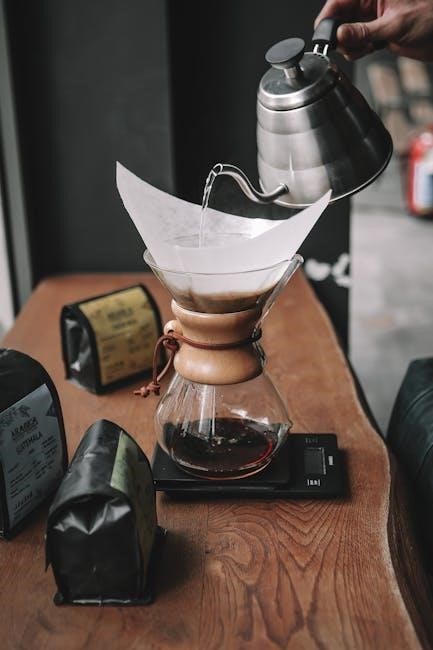Manual water softener regeneration is a process to clean resin beads by reversing ion exchange, removing accumulated minerals. It ensures soft water and system efficiency.
What is Water Softener Regeneration?
Water softener regeneration is the process of cleaning resin beads in a water softener to remove accumulated minerals like calcium and magnesium. This essential maintenance restores the beads’ ability to soften water effectively. Regeneration typically involves rinsing the resin with a concentrated salt solution, which removes trapped hardness minerals and rejuvenates the system. Automatic systems regenerate based on a preset schedule, while manual regeneration is performed as needed. This process ensures continuous soft water supply and prevents system inefficiency caused by mineral buildup. Regular regeneration is crucial for maintaining optimal water quality and extending the lifespan of the water softener. It’s a key part of system upkeep.
Why Manual Regeneration is Necessary
Manual regeneration is essential for maintaining your water softener’s performance and ensuring continuous soft water supply. Over time, resin beads become saturated with hardness minerals, reducing their ability to soften water effectively. Manual regeneration allows you to intervene when automatic cycles aren’t sufficient, such as after high water usage or if the system isn’t regenerating automatically. It also addresses issues like salt bridging in the brine tank, which can disrupt the regeneration process. By manually regenerating, you restore the resin’s capacity to remove minerals, prevent system inefficiency, and ensure optimal water quality. Regular manual regeneration helps maintain the longevity and efficiency of your water softener, keeping your water consistently soft.
When to Perform Manual Regeneration
Manual regeneration should be performed when your water softener isn’t automatically regenerating or when water hardness increases. Signs include stiff laundry, spotted dishes, or dry skin. If you’ve used an abnormally large amount of water, manual regeneration ensures the system resets properly. Additionally, if the control panel indicates a need for regeneration or shows an error, manual intervention is necessary. Before starting, ensure the brine tank has sufficient salt, as low levels can hinder the process. It’s also advisable to regenerate manually after cleaning the brine tank or replacing resin beads. Regular checks and timely manual regeneration maintain soft water quality and system efficiency.

Preparing for Manual Regeneration
Preparing for manual regeneration involves locating and turning the bypass valve to isolate the system, checking salt levels in the brine tank, and ensuring the water supply is off.

Locating the Bypass Valve
The bypass valve is typically found near the water softener system. It allows isolation of the softener from the home’s water supply during manual regeneration. Locate it by checking the system’s inlet and outlet pipes. The valve may be a lever or knob. Ensure it is in the correct position to stop water flow to the softener. This step is crucial to prevent interruptions during regeneration. Once located, turn or position the valve to isolate the system. Always refer to the manufacturer’s guide for specific valve locations and operation instructions if unsure.
Isolating the Water Softener System
Isolating the water softener system is essential before manual regeneration. Turn the bypass valve to direct water flow away from the softener. Ensure the valve is fully engaged to stop water supply to the system. This prevents untreated water from entering the softener during regeneration. Check that the softener is disconnected from the main water supply. If unsure, refer to the manufacturer’s instructions for proper isolation procedures. Isolating the system ensures manual regeneration proceeds without interference from incoming water; This step is critical for maintaining water quality and system performance during the process.

Checking Salt Levels in the Brine Tank
Before initiating manual regeneration, inspect the brine tank to ensure adequate salt levels. Low salt can hinder the regeneration process, reducing its effectiveness. Open the brine tank and visually check the salt level. It should be at least one-quarter full; If the salt is low, refill it according to the manufacturer’s recommendations. Avoid overfilling, as this can cause bridging or clogging issues. Also, ensure the salt is free from solidification or clumping, as this can disrupt brine flow. Proper salt levels are crucial for a successful regeneration cycle, ensuring the resin beads are effectively cleansed of minerals. Always follow the guidelines provided by the system’s manufacturer for optimal results.
Ensuring Water Supply is Turned Off
Before starting manual regeneration, it’s crucial to turn off the water supply to the softener. Locate the bypass valve, typically near the softener, and move it to the “bypass” position. This isolates the system from your home’s water supply, preventing any water from flowing through during regeneration. Double-check the valve’s position to confirm it is fully bypassed. If the water supply isn’t turned off, the regeneration process may be interrupted or less effective. Once the system is isolated, you can safely proceed with the manual regeneration steps. Always ensure the water supply is completely off to avoid any complications during the cycle. Consult your system’s manual if you’re unsure about the bypass valve’s location or operation.

The Manual Regeneration Process
Press the Regen button on the control panel to initiate manual regeneration. The system cycles through stages to clean resin beads, typically taking 1.5-2 hours to complete.
Pressing the Regen Button on the Control Panel
To start manual regeneration, locate the Regen button on the control panel. Press and hold it for 5 seconds until the display shows “Regen Today.” This initiates the cycle to clean the resin beads. Ensure the bypass valve is set correctly to isolate the softener during regeneration. The system will automatically progress through stages, flushing and recharging the resin. This process typically takes 1.5 to 2 hours. After pressing the button, monitor the display to confirm the regeneration cycle has begun. Once started, avoid interrupting the process to allow proper system cleansing and optimal performance.
Understanding the Regeneration Cycle Stages
The regeneration cycle includes several stages: backwash, brine rinse, and fast rinse. During backwash, water flows reverse to remove dirt from resin. Next, brine rinse rejuvenates resin by flushing it with saltwater. Finally, fast rinse ensures no salt remains. Each stage is crucial for restoring the softener’s efficiency. Understanding these steps helps troubleshoot issues and ensures proper system function. The process typically lasts 1.5 to 2 hours, depending on the system. Monitoring these stages ensures the softener operates effectively, providing soft water consistently.
Time Required for Manual Regeneration
Manual water softener regeneration typically takes between 1.5 to 2 hours to complete. The process involves multiple stages, including backwash, brine rinse, and fast rinse; During this time, the system cleans and rejuvenates the resin beads to restore their ability to remove water hardness. The exact duration may vary depending on the system size, water hardness, and the amount of resin. It’s important to avoid using water during regeneration to prevent interference. Plan accordingly to ensure uninterrupted water supply. Some systems may take up to 90 minutes, while others finish sooner. Always check your system’s manual for specific time requirements.

Monitoring the Regeneration Process
Monitoring the regeneration process ensures it runs smoothly. Start by pressing the Regen button and confirming the display shows “Regen Today.” Watch for the system to progress through stages without stopping. Listen for sounds indicating water flow and valve changes. Check the control panel for error messages or paused cycles. If issues arise, consult the manual or restart the process. Regular monitoring prevents interruptions and ensures optimal results. Proper observation guarantees the system functions correctly, restoring water softness efficiently. Stay nearby to address any unexpected stops or alarms during the cycle. This step is crucial for maintaining water quality and system performance. Consistent monitoring ensures a successful regeneration process every time.

Post-Regeneration Steps
After regeneration, flush the system to remove residual salt, check for proper functionality, reset the regeneration schedule, and test water hardness to ensure optimal performance.
Flushing the System After Regeneration
Flushing the system after regeneration is crucial to remove residual salt and ensure clean water flow. Open a faucet connected to the softener, preferably one with high flow, and let it run for 10-15 minutes. This process rinses the resin bed and clears any excess brine solution. Ensure the water runs until it flows freely without any salt or mineral residue. Repeat this step if necessary to achieve fresh, soft water quality. Proper flushing prevents any lingering hardness-causing minerals from affecting water quality. Regular maintenance ensures optimal performance and longevity of the water softener system.
Checking for Proper Functionality
After regeneration, verify the water softener’s functionality by testing water hardness. Use a test strip or digital meter to ensure water is soft. Check for leaks in connections and hoses. Inspect the control panel for error messages or unusual displays. Run a few cycles to confirm the system operates smoothly. Ensure the bypass valve is in the correct position and that water flows normally through all taps. If issues arise, consult the user manual or contact a professional. Proper functionality ensures soft water and system longevity. Regular checks help identify and address potential problems early, maintaining optimal performance and water quality.
Resetting the Regeneration Schedule
After manual regeneration, reset the system’s schedule to ensure automatic cycles resume correctly. Locate the control panel and navigate to the settings menu. Use the arrows or buttons to set the current time and desired regeneration frequency. Save the changes to update the schedule; Some models may require pressing and holding the “Regen” button until the display confirms the reset. Refer to the user manual for specific instructions, as procedures vary by manufacturer. A properly reset schedule ensures consistent soft water supply and prevents overuse of salt or premature system wear. Regularly updating the schedule maintains efficiency and extends the system’s lifespan.
Testing Water Hardness
Testing water hardness after manual regeneration ensures the process was effective. Use a water hardness test strip or a TDS meter to measure mineral levels. Simply dip the strip in water or submerge the meter for an accurate reading. Compare the results to the expected range for soft water, typically below 1 GPG. If hardness remains high, repeat the regeneration process or check for system issues. For precise analysis, send a water sample to a lab. Consistent testing helps maintain optimal water quality, ensuring appliances run efficiently and skin remains healthy. Regular checks prevent mineral buildup and confirm the softener’s performance over time.

Maintenance Tips for Water Softeners
Clean the brine tank regularly, check salt levels, inspect resin beads, and schedule professional maintenance every 5 years for optimal performance and longevity of the system.
Cleaning the Brine Tank
Cleaning the brine tank is essential for maintaining water softener efficiency. Every 3-5 years, scoop out old salt and dissolve any bridges with a plastic scoop. Rinse the tank thoroughly with warm water, ensuring no residue remains. Allow it to dry before refilling with salt. This prevents contamination and ensures proper regeneration. Regular cleaning avoids salt buildup and maintains optimal brine flow, which is critical for resin bead regeneration. Always follow manufacturer guidelines for specific cleaning instructions tailored to your system type. A clean brine tank ensures consistent soft water quality and prevents system malfunctions;
Refilling Salt Regularly
Refilling salt in the brine tank is crucial for effective water softener operation. Check salt levels monthly, ensuring the tank is never empty. Add high-quality water softener salt when levels drop below the recommended minimum. Use the correct amount to avoid overfilling, which can cause salt bridges. Regular salt refills ensure the resin beads can effectively remove hardness minerals during regeneration. Consistent salt levels maintain soft water quality and prevent system damage from mineral buildup. Always follow the manufacturer’s guidelines for salt type and quantity to optimize performance and extend the system’s lifespan. Proper salt maintenance ensures continuous soft water supply and efficient regeneration cycles.
Inspecting Resin Beads
Inspecting resin beads in your water softener is essential to ensure optimal performance. These beads, responsible for removing hard water minerals, can degrade over time. Regularly check for signs of wear, such as discoloration, mold, or increased water hardness. To inspect, turn off the water supply, drain the tank, and visually examine the beads. If they appear damaged or contaminated, replacement may be necessary. Typically, resin beads last 5-10 years, depending on usage and water quality. Neglecting inspections can lead to reduced softening efficiency. Always follow safety precautions when handling the system, and consult a professional if unsure about the condition of the beads.
Scheduling Regular Maintenance
Scheduling regular maintenance for your water softener ensures optimal performance and longevity. Plan to inspect and clean the system every 3-6 months, or as needed based on usage. This includes checking salt levels, cleaning the brine tank, and inspecting resin beads for damage. Regular maintenance helps prevent issues like salt bridging and resin degradation. Over time, neglecting maintenance can lead to reduced efficiency and higher energy costs. By staying proactive, you can extend the life of your water softener and ensure it continues to deliver soft, clean water. Consistent upkeep also prevents sudden system failures, saving you time and money in the long run.

Troubleshooting Common Issues
Troubleshooting common issues during manual regeneration involves identifying and addressing problems like the Regen button not working, salt bridging, low water pressure, and error messages. Resolving these promptly ensures smooth operation and maintains water quality.
Why the Regen Button May Not Work
The Regen button may not work due to electrical issues, such as a power outage or faulty wiring. It could also be a result of a stuck or damaged button. Additionally, internal system malfunctions, like control panel glitches or software errors, might prevent the button from functioning. If the button is pressed but no response occurs, it may indicate a deeper mechanical or electrical problem within the water softener. In such cases, checking the power supply, ensuring proper wiring, or resetting the system might resolve the issue. If not, professional assistance may be required to diagnose and repair the underlying cause.
Addressing Salt Bridging in the Brine Tank
Salt bridging occurs when a solid layer forms in the brine tank, preventing salt from dissolving. This issue can disrupt regeneration by blocking salt flow. To address it, start by breaking the salt bridge using a long-handled tool or broom handle. Gently stir the salt to create gaps and allow water to flow freely. After breaking the bridge, scoop out excess salt and rinse the tank with warm water. Refill the tank with the recommended type and amount of salt. Regularly cleaning the brine tank and ensuring proper salt levels can prevent future bridging. This maintenance ensures optimal regeneration and soft water production. Consistent upkeep is key to avoiding this common issue.
Fixing Low Water Pressure After Regeneration
Low water pressure after regeneration can result from debris in the softener or faulty valves. First, check the filter screen and clean or replace it if clogged. Ensure all valves are fully open, especially the bypass valve, to restore water flow. If pressure remains low, inspect the resin tank for blockages. Flush the system by running a manual regeneration cycle to clear any obstructions. Additionally, verify that the water supply lines are not kinked or restricted. If issues persist, consider professional maintenance to ensure proper function and water pressure. Regular checks can prevent such problems, maintaining optimal water flow and system efficiency. Consistent maintenance is essential for long-term performance. Always refer to your system’s manual for specific guidance.
Resolving Error Messages on the Control Panel
Error messages on the control panel indicate issues that need attention. Start by identifying the specific error code or message displayed. Refer to your system’s user manual for explanations of common errors. Often, restarting the softener by pressing and holding the Regen button for a few seconds can resolve minor glitches. Ensure the salt levels in the brine tank are adequate, as low salt can trigger error messages. If the issue persists, check for blockages in the resin or brine tank and clean them if necessary. For complex errors, consult a professional to avoid further system damage. Regular maintenance and monitoring can help prevent recurring error messages and ensure smooth operation. Always follow manufacturer guidelines for troubleshooting specific issues. Proper resolution of errors is crucial for maintaining water quality and system longevity. If unsure, seek guidance from the manufacturer or a certified technician.

Best Practices for Manual Regeneration
Always use the correct amount of salt, avoid over-regeneration, and keep the system clean. Follow manufacturer guidelines to ensure optimal performance and longevity of the softener.
Using the Correct Amount of Salt
Using the correct amount of salt is crucial for effective manual regeneration. Typically, 15 grams of salt (or 250 ml of water) is recommended for optimal ion exchange. Excess salt can lead to salt bridging, while insufficient salt may fail to regenerate the resin properly. Always check your water softener’s manual for specific guidelines, as requirements may vary. Ensure the brine tank is filled appropriately before initiating the regen cycle. Avoid overfilling, as this can cause maintenance issues. Proper salt usage ensures the resin beads function efficiently, removing hardness minerals and restoring soft water quality. Regularly monitor salt levels to maintain consistent performance.
Avoiding Over-Regeneration
Avoiding over-regeneration is essential to maintain the longevity of your water softener. Over-regenerating wastes salt and water, increases energy costs, and may damage the resin beads. It can also lead to excessive wear on the system’s components. To prevent this, follow the manufacturer’s recommended regeneration schedule and adjust settings based on water usage. Manual regeneration should only be performed when necessary, such as after unusually high water use. Keep track of your water consumption patterns to avoid unnecessary cycles. Regular maintenance, like cleaning the brine tank, also helps prevent issues that might lead to over-regeneration. Ensure the system operates efficiently by adhering to guidelines and monitoring performance closely.
Keeping the System Clean
Keeping your water softener system clean is crucial for optimal performance. Regularly inspect and clean the brine tank to prevent salt bridging and buildup. Ensure the salt level is adequate, as low salt can lead to inefficient regeneration. Occasionally, dissolve any hardened salt or debris by adding warm water to the tank. Clean the venturi valve and flow restrictor if you notice reduced water flow. Additionally, check the resin beads every few years and rinse them if necessary. A clean system ensures better water quality and prevents maintenance issues. Schedule periodic deep cleans as recommended by the manufacturer to maintain efficiency and longevity.
Following Manufacturer Guidelines
Always follow the manufacturer’s instructions for manual regeneration to ensure your water softener operates efficiently. Check the user manual for specific steps tailored to your system. Pressing the Regen button is a common method, but timing and salt requirements may vary. Some systems may need manual salt addition or bypassing before starting. Adhere to recommended salt levels and regeneration frequencies to maintain optimal performance. Manufacturer guidelines also include tips for troubleshooting and maintenance. By following these instructions, you can prevent issues like over-regeneration or salt bridging. Regularly review the manual to stay updated on best practices and ensure your system runs smoothly for years to come.
Manual water softener regeneration ensures optimal performance and water quality. Regular maintenance and adherence to guidelines extend system longevity and prevent issues like salt bridging or low pressure.
Importance of Regular Regeneration
Regular regeneration is crucial for maintaining water softener efficiency and water quality. It removes accumulated minerals, preventing system damage and ensuring soft water consistently. Over time, resin beads capture hardness minerals, and without regeneration, they lose functionality. Regular cycles prevent salt bridging and maintain proper ion exchange. This process also addresses issues like low water pressure and error messages. By keeping the system clean and functional, regeneration extends the lifespan of the softener and protects household appliances from scale buildup. Consistent regeneration ensures optimal performance, safeguarding your investment and providing reliable access to softened water for daily use.
Benefits of Manual Regeneration
Manual regeneration offers precise control over the timing and process, ensuring optimal system performance. It allows addressing specific issues like high water usage or salt bridging promptly. This method guarantees the resin beads are thoroughly cleaned, restoring softening capacity. Regular manual cycles prevent mineral buildup, maintaining water quality and appliance efficiency. It also extends the lifespan of the softener by preventing long-term damage. Manual regeneration is cost-effective, as it avoids potential issues caused by neglected maintenance. By ensuring the system operates at peak efficiency, manual regeneration provides consistent access to soft water, protecting your home and health from hard water effects.
Ensuring Longevity of the Water Softener
Regular manual regeneration is crucial for extending the lifespan of your water softener. It prevents mineral buildup and salt bridging, which can damage internal components. By maintaining clean resin beads, the system operates efficiently, reducing wear and tear. Proper salt levels and timely regeneration cycles ensure the softener functions optimally. Cleaning the brine tank periodically and checking for blockages also contribute to longevity. Consistent maintenance prevents corrosion and extends the life of the resin, ensuring reliable soft water production. A well-maintained system reduces repair needs and replacement costs, providing long-term benefits for your home and water quality.
Final Tips for Optimal Performance
To ensure your water softener operates at its best, always follow manufacturer guidelines for manual regeneration. Regularly check and refill salt levels, as low salt can reduce efficiency. Clean the brine tank periodically to prevent salt bridging and maintain proper flow. After regeneration, flush the system thoroughly to remove residual salt and minerals. Monitor the regeneration cycle to ensure it completes successfully and address any issues promptly. Keeping the control panel and valves clean prevents malfunctions. By adhering to these practices, you maximize soft water quality and extend the system’s lifespan, ensuring consistent performance and reliability over time.